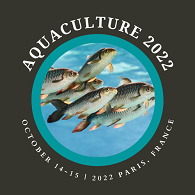Day 1 :
Keynote Forum
Nyan Taw
Shrimp Aquaculture Consultant (Former; Chief Technical Advisor & Consultant for FAO projects of the UN and WB)
Keynote: Various intensive shrimp farming systems in Asia: Commercial implementation of biofloc and RAS production systems help control shrimp farming diseases
Time : 09:55-10:35

Biography:
Dr Nyan Taw received his Ph.D. from the University of Tasmania, Australia. He served as short term consultant for FAO and World Bank funded projects in Saudi Arabia and Vietnam. He was a technical counter-part for ADB and JICA projects to develop the fisheries sector in Myanmar from 1976 to 1987. In 1988, he joined the FAO of the UN and served in aquaculture projects in Indonesia, Vietnam and the Philippines culminating the position of CTA. From 1995, Dr Nyan served as Production Director at a number of locations in Indonesia. In 2002, he joined CP Indonesia, as VP where he initiated biofloc technology. Later he served as SVP for Dipasena Group, Indonesia.
Abstract:
Before the mid-1990s, the major diseases affecting the farmed shrimp industry were of bacterial origin. But in Asia and from late 1994, the appearance of various, major viral diseases – like White Spot Syndrome Virus (WSSV), Yellow Head Virus (YHV), Infectious Myonecrosis Virus (IMNV) and others – led to changes in the design and operation of some shrimp farms to help prevent outbreaks and dissemination of viral diseases. More recently, WSSV outbreaks in Saudi Arabia in farming operations for Indian white shrimp (Penaeus indicus) provided more evidence that additional biosecurity was needed. And since 2009, outbreaks of a new bacterial disease, Acute Hepatopancreatic Necrosis Syndrome (AHPNS) – which started in China and spread to Asia and later Central America in 2015 – has caused losses of billions of dollars. In Australia WSSV outbreak in early 2017 at black tiger shrimp (Penaeus monodon) farms provide additional evidence for the need to change shrimp production systems.
Because of old and newly emerging viral and bacterial diseases affecting their farmed shrimp industry, some years ago various Asian countries started developing and using biofloc and recirculation aquaculture system (RAS) production technologies and/or treating incoming water for culture operations and wastewater treatment as biosecurity measures for disease prevention and control. Many production systems are used by Asian shrimp growers – from single-pond base management to larger RAS systems – but many have yet to reduce their environmental impact due to their wastewater discharges.
Examples of different biofloc and recirculation aquaculture (RAS) shrimp farming systems used in Asia in the last two decades, including some of the projects I have personally been involved with and provided technical expertise, as well as some perspectives on these technologies are provided. Large integrated shrimp farms in Indonesia: Dipasena group in Lampung, PT CPB in Lampung and PT SAJ in Sumbawa and Blue Archipelago Bhd projects in Kedah and Terengganu in Malaysia.
In any aquaculture business, sustainability of a system can improve profits. With emerging disease problems, treating wastewater discharged from farming facility or RAS is of utmost important. What investors, shrimp farmers and technicians need to be aware of is that, whatever waste is discharged into the environment, it will likely com/e back to you in the form of disease sooner or later.
Keynote Forum
Pooja harshan
Cochin university of Science and Technology(CUSAT)
Keynote: Molecular Insights into the de novo transcriptome of the grey bamboo shark, Chiloscyllium griseum
Time : 11:00-11:30

Biography:
Ms. Pooja Harshan completed her five year integrated BS-MS (Biotechnology) from the Kerala Agricultural University, Thrissur, Kerala by securing a GPA of 8.9 on 10 point scale. She was the university topper for 2012 batch and also acquired DST-INSPIRE fellowship for doing PhD in central institutes of India. She was enrolled for PhD under the Faculty of Marine Sciences, Cochin University of Science and Technology (CUSAT) IN 2019. Currently, she works on the immune and stress related genes, a transcriptome based study on grey bamboo sharks. Also, one paper is under construction for submission to UGC approved peer-reviewed journal.
Abstract:
The chondrostean order Orectolobiformes, encompasses various model organisms including the grey bamboo shark that play significant role in uplifting biological research. The main objective was to generate a de novo reference transcriptome for the grey bamboo shark, Chiloscyllium griseum (Chondrichthyes; Hemiscyllidae) exercising paired end (PE) illumina RNA sequencing technology.The present work focuses on generating a de novo illumina paired-end sequencing library data set of the grey bamboo shark, Chiloscyllium griseum using an illumina HiSeq X10 PE 10 platform. The gene panel obtained has to be interrogated for any potential biological function in particular, ‘vertebrate immunity’ through comparative transcriptomics strategy using a model or a reference organism. The model chosen for the present study is Callorhinchus milii (Elephant shark/Ghost shark). 348,764 transcripts were generated after the de novo transcriptome assembly and 70,647 transcripts could find a homolog matched with the Uniprot database. These transcripts were further subjected to organism annotation and functional assignment of gene ontology (GO) terms. Also, GO terms for the available transcripts were retrieved where ever possible and grouped into different category based on the ‘biological process’,‘cellular component’ and ‘molecular function’. Busco analysis was performed to assess the completedness of transcriptome assembly. Five candidate genes novel to immunological pathways were identified in silico and the potential function of the corresponding proteins was predicted using InterPro Scan. This work yields a transcriptome dataset of Chiloscyllium griseum that can be used as a draft representative of large-scale catalogue of genes corresponding to both innate and adaptive immune response in Chiloscyllium.
Keynote Forum
Imen CHEBBI
Università degli studi di Messina
Keynote: Parasitological study and its role in fisheries management and stock assessment of Boops boops (Lineauses, 1758) along the Tunisian coast
Time : 11:30-12:00

Biography:
Imen CHEBBI is PhD student at the age of 27 years at the University of Sfax, Tunisia. And now enrolled at the University of Messina as an Erasmus student.
Abstract:
The bogue, boops boops is an economically important fishery resource and commonly captured in the Mediterranean, and its diversity in parasites has been used as a tool to differentiate between stocks along Tunisia since it is widely acceptable in fisheries management.
In this study, a total of 90 fish are investigated from three localities off Tunisia including Kelibia, Mahdia, and Zarzis. Fifteen species of parasites totaling 1270 individuals were harvested from B. boops, whereas ten parasites were used as biological tags. Based on Mahalanobis distance, each parasite species shows a great importance in the discrimination between groups. Tetraphyllidea larvae are the most influential parasites in determining the position of samples belonging to Kelibia. Monogenean species and Hysterothylacium sp. are the most important species for determining the position of samples from Mahdia. Specimens from Zarzis are characterized by the absence of the four Monogenean species and the Tetraphyllidea larvae. Parasites allocate B. boops population correctly to their origin communities with an accuracy of 83.3%. These results were corroborated by the discriminant analyses, highlighted the presence of three stocks, and improved that the parasitological method can be considered as a reliable key to provide imperative information for discriminating among B. boops stocks in Tunisian waters.
Keynote Forum
Mehrdad Kamali
Islamic Azad University, Iran
Keynote: Prevention, control and protection methods of green-blue algae blooms in aquaculture farms
Time : 12:00-12:30

Biography:
Mehrdad Kamali has completed his PhD at the age of 32 years from Azad University (IAU) in fish nutrition subject. Nowadays, he is the production manager of Makran company, a premier In-door shrimp culture system in Iran. He has published more than 15 papers in Persian journals and conferences. He has been serving as an scientific reviwer of some ISI journals.
Abstract:
Green-blue algae are one of major reasons of algal blooms in world¢s eutroph aquaculture farms. Some of these algae are cause to produce toxins, decrease water quality and depletion of dissolve oxygen lead mass mortality of fishes and other aquatic organisms. Although, chemical component secrete to these algae produce bad odour and taste in aquatic body composition and creats high economic losses. Also, the aim of this study according to negative effect of these organisms was introduce prevention, control and protection methods against of these algae according to review paper format. The results show that four different methods such as managerial (balance in N:P ratio; aquatic plants management; water exchange; water parameters monitoring and applied of barely straw), mechanical (aeration; clay flocculation; filtration and physical barrier), chemical (applied different type of algaecide; create a shadow on water surface; applied of endothal-Amin salt and phoslock technology) and biological (biological manipulation by filter feeder fishes and applied of zooplanktons and microbial communities) are applied against green-blue algae in aquaculture industry. Culturists should be choice one or some cost-benefit methods according to target water source condition.
Keynote Forum
Amina Benmehal
University of Mostaganem, Algeria
Keynote: Study of the genetic variability of two Algerian Artemia populations from two different areas.
Time : 12:30-1:00

Biography:
Amina Benmehal
1999 :She got the baccalaureate natural science option.
2005 : She got the diploma of state ingenior in fisheries ressources.
2016 :Master certificate in exploitation and protection of marine ressources.
2015 : Leading a pedagogic laboratory of fisheries ressources at the university of Abd hamid Ibn Badis Mostaganem Algeria.
2018 :Beside my work in the laboratory ,carrying on the researches on Artemia preparation of my doctora thesis.
Abstract:
Artémia is a Small crustacean branchiopod anostraca of aquacultural interest remains among the most essential foods used in fish and shellfish larviculture. Nowadays there is almost no genetic data on zooplanktonic organisms of extreme environments and salines of Algeria, this has prompted us to think about conducting a study exposing the questions directly related to the diversity and genetic variability of the genus Artemia that lives in this type of environment.The sampling was performed on two different longitudes, distributed as follows:
- eastern zone : ( sebkhet el zemoule (Oum El bouaghi)( 35° 52′ 57″ N-6° 32′ 54″ E)
- western zone : Saline de Betioua (Oran)( 35° 41′ 21″ N-0° 18′ 15″ w) .
The taxonomic identity of these Artemia populations was determined using phylogenetic analysis and sequencing. The results showed that the examined population belongs to two species, Artemia Salina and Artemia parthenogenetica showing striking mutations. In the present study, we sequenced the cytochrome oxidase subunit I (COI) and examined the phylogenetic relationships, haplotype network and population genetic structure of Artemia from tow geographical localities in Algeria.
Keynote Forum
Amina TAHLAITI
University of Mostaganem, Algeria
Keynote: STUDY OF THE PROBIOTIC POTENTIAL OF LACTICS BACTERIA ISOLATED FROM Artemia sp.
Time : 2:00-2:30

Biography:
Will Update Soon..
Abstract:
Aquatic lactic acid bacteria isolated from fish, shellfish and seafood play a very important role in the intestinal flora and can be used as probiotics in aquaculture farming. The aim of this work was to isolate bacteria with high probiotic potential from Artemia sp. collected from the Sidi Bouziene (Relizane) and Bethiou (Oran) saline. Some lactic acid bacteria were tested for their antagonistic power towards indicator strains of the natural environment. The interesting strains were tested for their lactic acid production, their biofilm production, as well as their biosafety (antibiotic resistance test and hemolysis test). The results showed that some lactic acid bacteria had antagonistic activity against a wide spectrum of indicator strains. They showed a good production of lactic acid, and a medium to low production of biofilm.
Keynote Forum
Nabil Berrahal
Valorisation des Ressources Marines Littorales et Systématique Moléculaire, Algeria
Keynote: LIPID EXTRACTION FROM A MACROALGUE: BROWN ALGAE (Cystoseira stricta) COLLECTED FROM THE MOSTAGANEMOISE COAST (ALGERIA)

Biography:
Will update soon...
Abstract:
At the world level, the seaweed industry is in constant progression, with a production (more than 8 million tons per year) which doubled since the 80s and a global turnover of approximately 7 billion US dollars. Brown seaweeds are the most common and widely cultivated.
Seaweeds offer prospects of applications in many industrial sectors: vegetables, food processing, in the form (hydrocolloids) for their thickening power (agar) or gelling (alginate, carrageenan), agriculture, soil improvers (calcareous seaweeds), chemical industry (biodiesel, plastic, molecules of pharmaceutical interest), cosmetics and medicine.
Our work has a double objective; on the one hand the chemical valorization of Cystoseira stricta by determining the rate of lipids and on the other hand, the bacteriological analyses of the two stations to know more about the environmental conditions of this species.
According to the obtained results, we can say that the studied alga has a more or less interesting value seen the rate of lipids quantified in the species living in the station of Stidia compared to that of the Sablettes. These results allowed us to confirm the richness of this kind of alga in organic substances.
Key words: Brown algae, Cystoseira stricta, lipids, bacteriological analyses.

